by Henry Doktorski
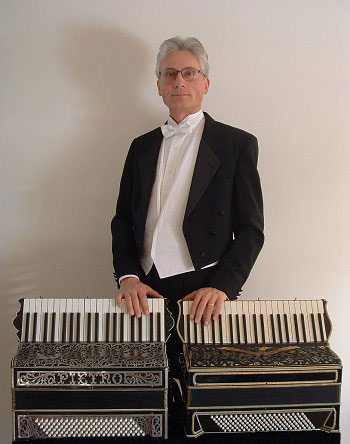 These
two historic accordions will be installed with much fanfare in A World of Accordions
Museum at 1401 Belknap Street in Superior, Wisconsin, on Sunday April 3, 2005.
These
two historic accordions will be installed with much fanfare in A World of Accordions
Museum at 1401 Belknap Street in Superior, Wisconsin, on Sunday April 3, 2005.
The two instruments were donated to A World of Accordions Museum by
Guido's son, Count Guido Roberto Deiro (in collaboration with Dr. Allan A. Atlas,
curator of the Deiro Archive at the Center for the Study of Free-Reed Instruments
at the Graduate Center of the City University of New York), and Pietro's granddaughter,
Sandra Deiro Cattani.
The author of this article, Henry Doktorski - will conduct a workshop on Sunday afternoon at 1.00 PM, April 3, and registrants will have the opportunity to hear and play these two historic instruments. At 3.00 PM in the afternoon, the author will perform a full-length recital featuring exclusively the original compositions of Guido and Pietro Deiro, including their most popular marches, waltzes, tangos, polkas, foxtrots, and overtures. For more information about the workshop and recital, contact museum founder and curator, Dr. Helmi Harrington, at 218-393-0245 or accordion@sprynet.com
Following
are a series of photographs by the author of the two Guerrini accordions owned
and played by Guido and Pietro Deiro. For more about Guido Deiro visit http://guidodeiro.com.
For more about the author, visit http://henrydoktorski.com
Guido Deiro's Royal Method for the Piano Accordion (Nicomede Music, Altoona, Pennsylvania, 1936) provided a short biographical sketch of the first star of the piano-accordion:
This
master of the Piano Accordion was born in Salto Canavese near Turin in Piedmont,
Italy, and started to play the accordion when nine years old, being the first
of his family to play this instrument. This was against the wishes of his father
who wanted to make a grocer out of the small Guido. But in his own words, "with
music singing in my heart there was no inspiration in potatoes and beans,"
and by the time Guido was 14 he was in Switzerland, playing professionally on
the accordion and was already making a name for himself as a virtuoso of this
instrument.
His work took him to Germany and it was there he first became acquainted
with what is now known as the piano accordion and resolved to possess one as soon
as possible. Returning to Italy in 1906 to serve in the army, he was assigned
to the band of the 29th infantry, playing several wind instruments but featuring
the bass. The attractiveness of the new instrument heard in Germany was not forgotten
and one was built to order for his use. Additional fame came with the skillful
use of this resourceful instrument, and in 1908 the innate ambition and restlessness
of the true musician asserted itself and Deiro came to America, landing in Seattle.
The success which had attended the use of this new instrument, his own confidence
in its musical worth, and the skill which he had acquired in its use led Deiro
to put to the test an idea of his own that had long been forming, the idea that
this instrument was good enough to hold its own in any company and with any kind
of music -- elevating it to a concert instrument of the first rank. Previous to
this time it had not had this distinction, being considered an instrument for
street playing and similar uses only.
In 1910, Deiro was booked on the
bill at the American Theatre in San Francisco, as the Premier Piano Accordionist
-- a designation that could not be more correct, for up to this time the instrument
had not been used on the stage. Deiro, at this time, also furnished the name by
which the instrument is since known, -- translating its Italian name of "Armonica
Sistema Piano" to "Piano Accordion." As the crucial moment approached
when his confidence was to be put to the test, we can well imagine the anxiety
of this Italian musician. Would he be a flop, and the new Piano Accordion prove
unable to hold its own? Financially and artistically, it was a critical time for
Deiro. In his own words, as he told it to us: "I stepped into the spot-light,
I and my piano accordion, right into the glare of it. There was the time and the
place to show what could be done with this instrument. It's now or never, I told
myself, and began to play. I forgot about my fingers and the keys of wood and
celluloid. I only remembered that my heart was full of melody and I wanted to
show the people in the theatre how beautiful that melody was."
Guido's younger brother,
Pietro (1888-1954), first made his living as a miner before he pursued a career
as a professional musician. First Pietro worked in the iron mines near Metz, Germany,
while Guido performed at a local Metz tavern. In 1907 Pietro immigrated to the
United States to live with his uncle and work in the coal mines near Cle Elem,
Washington. After some time, he decided to follow in his older brother’s
footsteps, perhaps inspired by Guido's success. Pietro explained, "When we
were children together I was always inspired by his playing before I began to
play the accordion. The thought uppermost in my mind in those days was if I could
only become as good a player as Guido." (Typewritten undated article by Pietro
Deiro found in the Deiro Archive, Center for the Study of Free-Reed Instruments,
Graduate Center, City University of New York)
During the summer of 1908, Pietro got a job at the Idaho Saloon in Seattle. He played a three-row sixty-bass diatonic button accordion with a pianist, and made $18 per week. Apparently Pietro did not know how to play the left hand bass and chord buttons, and therefore he was dependent on the pianist to provide accompaniment.
Two months later during the autumn of 1908, Guido arrived in Seattle and got a job playing his piano-accordion as a soloist at another Seattle tavern, the Jackson Saloon, also for $18 per week. Pietro recognized the advantages of his brother’s piano-accordion (audiences were fascinated by its novel appearance and sound, and after he learned how to play the left hand, he could make twice as much money as he wouldn’t have to share his salary with an accompanist), and asked his brother to teach him how to play the instrument.
In 1910, Guido was discovered by a talent scout and began playing professionally on the Orpheum vaudeville circuit as a solo piano-accordionist: "America's Premiere Piano Accordionist." After some time, Pietro also joined the vaudeville circuit and signed with a competing agency. Both brothers began making records, Guido for Edison and Columbia, and Pietro for Victor and Decca.
One modern scholar
described the importance of the Deiro brothers, "Put simply, they were the pioneers of the piano accordion in America. Having emigrated from their native
Italy around 1908, they had, within a few years, successfully established their
solo acts as major attractions both in vaudeville and on record; and for nearly
two decades thereafter - until roughly the time of the Depression - they were
the leading popularizers of the instrument in this country. . . . The records
of both brothers were enormously popular in their day, and, along with their vaudeville
stardom, helped to propel them to the status of minor celebrities in American
pop culture by the late teens." (Peter Muir, "The Deiro Recordings," The Free-Reed Journal, vol. 4 [Center for the Study of Free-Reed Instruments:
Fall 2002])
The
accordions which the two Deiro brothers played were built by the Guerrini Company
in San Francisco operated by Pasquale Petromilli, Antonio Petromilli, Finan Piatanese
and Colombo Piatanesi. These instruments were quite different from the modern
accordions we are used to hearing and playing today. They had no tone chambers,
so their sound was brighter.
Like
modern accordions, they had four sets of reeds for the right hand, but they were
organized differently from today’s instruments which contain one set of low
reeds (bassoon) which sounds one octave lower than written, two sets of middle
reeds (violin) which sound as written, and one set of high reeds (piccolo) which
sounds one octave higher than written. Guido and Pietro’s instruments had
one set of low reeds and three sets of middle reeds, which were all dry-tuned,
unlike the wet-tuned French musette accordion. There were no piccolo reeds in
these early instruments. The reeds were made from steel.
Guido’s
instrument (stamped on the reed blocks with the date “June 3, 1926”
and the names “P. Petromilli & C. Piatanesi”) had a right-hand keyboard
of 41 notes, beginning from A below middle C to B three octaves higher. Pietro’s
instrument (stamped on the reed blocks with the date “June 6, 1917”
and also with the names “P. Petromilli & C. Piatanesi”) had a right-hand
keyboard of 39 notes, beginning from G below middle C to A three octaves higher.
The black keys were narrower than the black keys on modern instruments.
Pietro’s
instrument had 120 bass and chord buttons like the modern accordion, but Guido’s
instrument had 140 buttons which included an extra row of augmented chord buttons.
There were three reed blocks for the left-hand, encompassing sixty pitches (a
range of five octaves). The lowest pitch on Guido’s bass buttonboard was
a C two octaves below middle C. Pietro’s instrument descended three pitches
lower: to an A.
Both
instruments had a register shift operated by the thumb along the back of the right-hand
keyboard. It had two settings: (1) the master stop in which all four sets of reeds
sounded, and (2) the violin stop, which pushed an aluminum plate across the air
holes and blocked the bassoon reeds, thereby permitting only the three sets of
middle reeds to sound.
Contemporary
reviewers were amazed by the sound of Guido’s instrument, “Deiro gives
to the accordion the sonorousness of the organ and at the same time the exquisiteness
and subtleness of the violin.” (Undated newspaper clipping, ca. 1910-1912,
from the Guido Deiro Scrapbook, Book 1)
Guido’s
accordion had a mute for the left-hand manual, a two-position switch operated
by the left-hand thumb on the back panel of the instrument which opened or closed
a series of round portholes on the back panel. Pietro’s instrument had a
brass air-bar instead of an air button, which allowed him to blow out or suck
in extra air through the bellows if needed no matter where his hand lay up or
down the button-board. Guido’s instrument had two air buttons, located at
each end of the bass panel
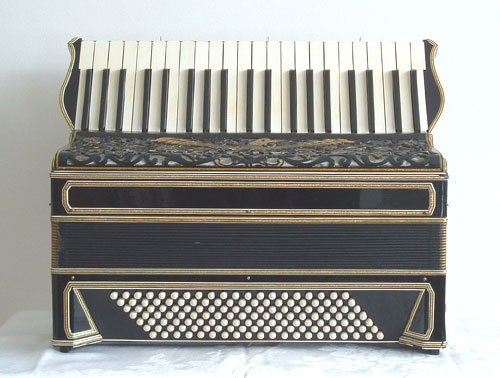 | |
Front
view | |
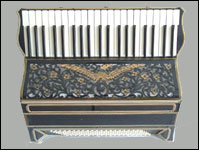 | 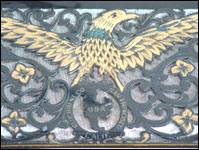 |
Top
view | Detail
of grill |
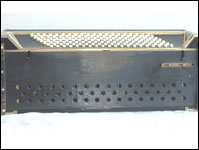 | 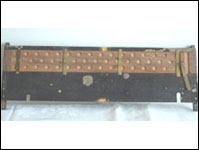 |
Left-hand
panel, showing open mute holes | Inside
of left-hand panel, showing the mute sliding mechanism |
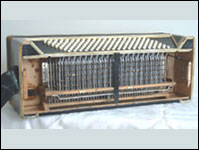 | 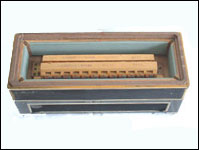 |
Bass
mechanism | Bass
reed blocks, showing stamps dated June 3, 1926 |
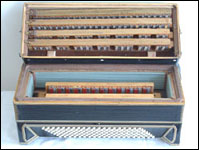 | 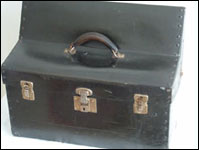 |
Treble
and bass reed blocks | Custom-fitting
accordion case |
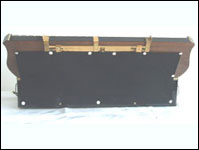 | 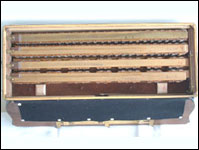 |
Back
of right-hand keyboard, showing register shift | Treble
reed blocks |
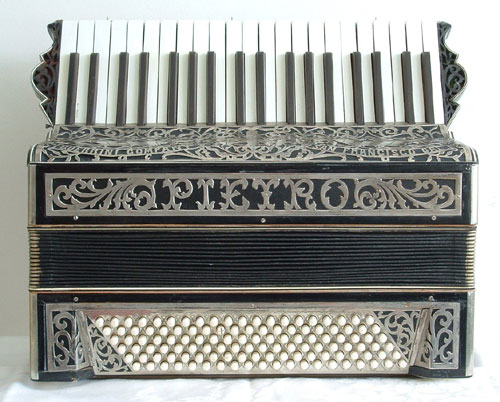 | |
Front
view | |
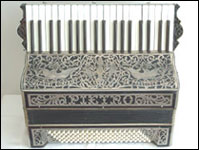 | 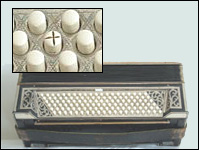 |
Top view, showing grill | Left-hand
bass and chord buttons, showing x filed on C bass, and the brass air bar |
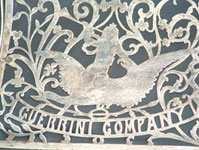 | 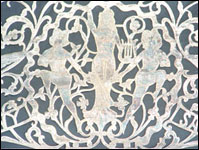 |
Detail
of grill, left | Detail
of grill, center |
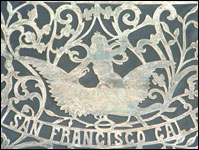 | 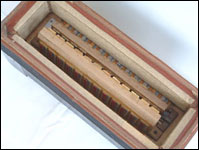 |
Detail
of grill, right | Bass
reed blocks |
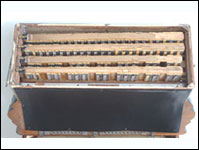 | 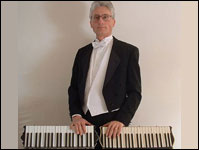 |
Treble
reed blocks | The
author and the Deiro accordions |